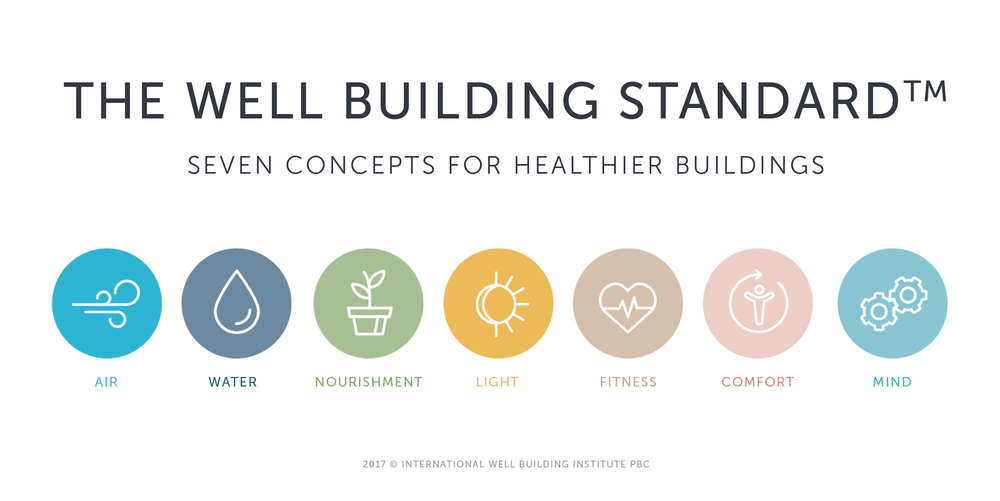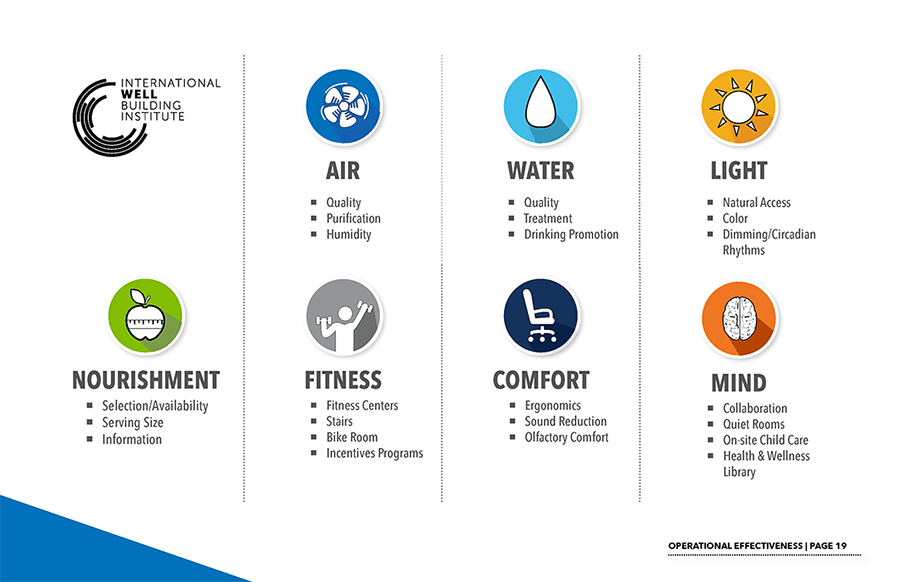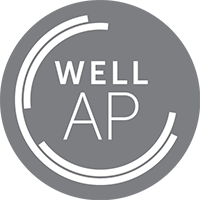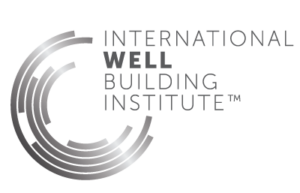What is a WELL Building?
The WELL Building Standard is the first building standard to focus exclusively on the health and wellness of the people in buildings. The WELL Building Standard is a performance-based system for measuring, certifying, and monitoring features of the built environment that impact human health and wellbeing.
It combines best practices in design and construction with evidence-based medical and scientific research – harnessing the built environment as a vehicle to support human health and well-being. WELL is grounded in a body of research that explores the connection between the buildings where we spend more than 90 percent of our time, and the health and wellness impacts on us as occupants.
WELL Certified spaces can help create a built environment that improves the nutrition, fitness, mood, sleep patterns and performance of its occupants. WELL sets performance requirements in seven categories, or Concepts, relevant to occupant health and well-being in the built environment: air, water, nourishment, light, fitness, comfort and mind. Each WELL Feature is designed to address issues that impact the health, comfort or knowledge of occupants through design, operations and behavior. The current WELL standard is optimized for commercial and institutional office buildings, organized into Project Types of New and Existing Buildings, New and Existing Interiors and Core and Shell, which take into account the specific set of considerations that are unique to a particular building type. Pilot Programs are now available for new market sectors including retail, multifamily residential, education, restaurant and commercial kitchen projects.
WELL is managed and administered by the International WELL Building Institute (IWBI), a public benefit corporation whose mission is to improve human health and wellbeing through the built environment.
The WELL Building Standard is third-party certified by the Green Business Certification Incorporation (GBCI), which administers the LEED certification program and the LEED professional credentialing program.
Why WELL?
A WELL Certified project has the potential to add measurable value to the health, well-being, productivity, and happiness of building occupants. By placing people at the heart of design, construction, operations and development decisions, we have the ability to add value to real estate assets, generate savings in personnel costs, and enhance the human experience, health and well-being. Prioritizing WELL also provides the opportunity to stand at the forefront of innovation in the sustainable and healthy building movement.

WELL Certification is positioned to provide added value for commercial and Institutional projects. Physical workplace is one of the top three factors affecting performance and job satisfaction. Personnel costs significantly outweigh the costs for design and construction and maintenance and operations. Addressing occupant health channels resources towards reducing the largest line item in the 30-year costs of a building – the personnel – offering a meaningful return on investment.
What’s the Process To Get A Building WELL Certified?
Registration
WELL Certification begins with registration through WELL Online. Upon registration, a WELL coaching contact from IWBI will be assigned to the project. The WELL coaching contact will support the project administrator and/or WELL AP, providing an additional resource to help navigate the WELL Certification process smoothly, overcome challenges, brainstorm solutions and inspire effective implementation of WELL.
Documentation
They supplement the role of the WELL Assessor, who is assigned at the time of documentation submission, and whose role is to ensure that a project complies with WELL’s requirements. The WELL Assessor is responsible for a project’s documentation review and Performance Verification.. The next step in the certification process is Documentation Review, in which the documentation required for each feature being pursued is submitted to GBCI. The WELL Assessor then performs a technical review of the submitted documentation. Two rounds (preliminary and final) of review are included.
Performance Verification
Once the project passes the documentation review phase, the project may move on to Performance Verification, in which a series of post-occupancy performance tests are performed.
Certification
Once it is demonstrated through these two steps that the project has achieved all of the applicable Preconditions and desired Optimizations, the project achieves WELL Certification. Recertification ensures that the project maintains the same high level of design, maintenance, and operations over time.
WELL Certification v1 is valid for three years. In order to maintain a current certification, WELL Certified projects must undergo Performance Verification again and apply for recertification to verify that the building continues to perform in accordance with the requirements of the WELL Building Standard v1 before the end of the three-year Certification period. During the Certification period, annual data must also be submitted for the features that require more frequent reporting.
What’s Unique About WELL?
While studying for my WELL Accredited Professional (WELL AP) credential exam, I learned about several features that make a WELL Building stand out from a LEED or Energy Star building. Some of the features that I found interesting were the cleaning protocols, air quality monitoring, water fountain requirements, and bans on trans fat and high-sugar drinks and foods. I was also fascinated by the requirements around lighting. The importance of the body’s circadian rhythm is highlighted along with the importance of bringing in daylight while controlling glare on computer screens and work surfaces. Placing stairs at a point where they can be easily accessed and providing fitness programs and standing desks were keys to the Fitness concept. Reducing background noise and giving occupants the ability to move work stations are required to improve overall comfort. Paid maternity and paternity leave, on-site child care and short out-of-town trips reflect WELL’s emphasis on employee work-family balance.

I am excited to see what the future holds designing buildings around the health and wellness of the occupants and how it will effect employee recruitment and retention. Not to mention the long-term health of the human race!
For more information on WELL – visit https://v2.wellcertified.com/
Luke Powell, WELL AP, LEED AP
Vice President
Air Equipment Company




